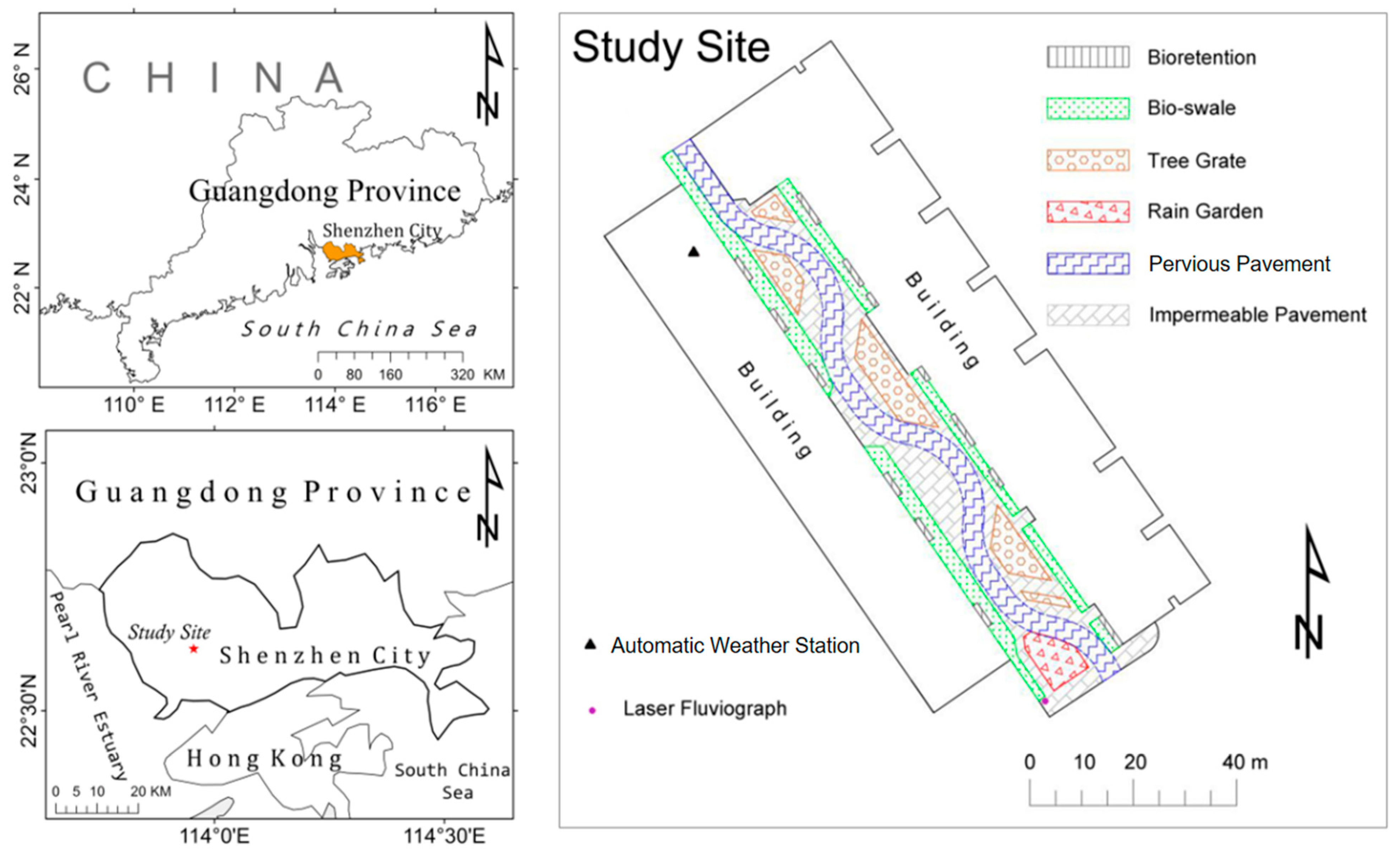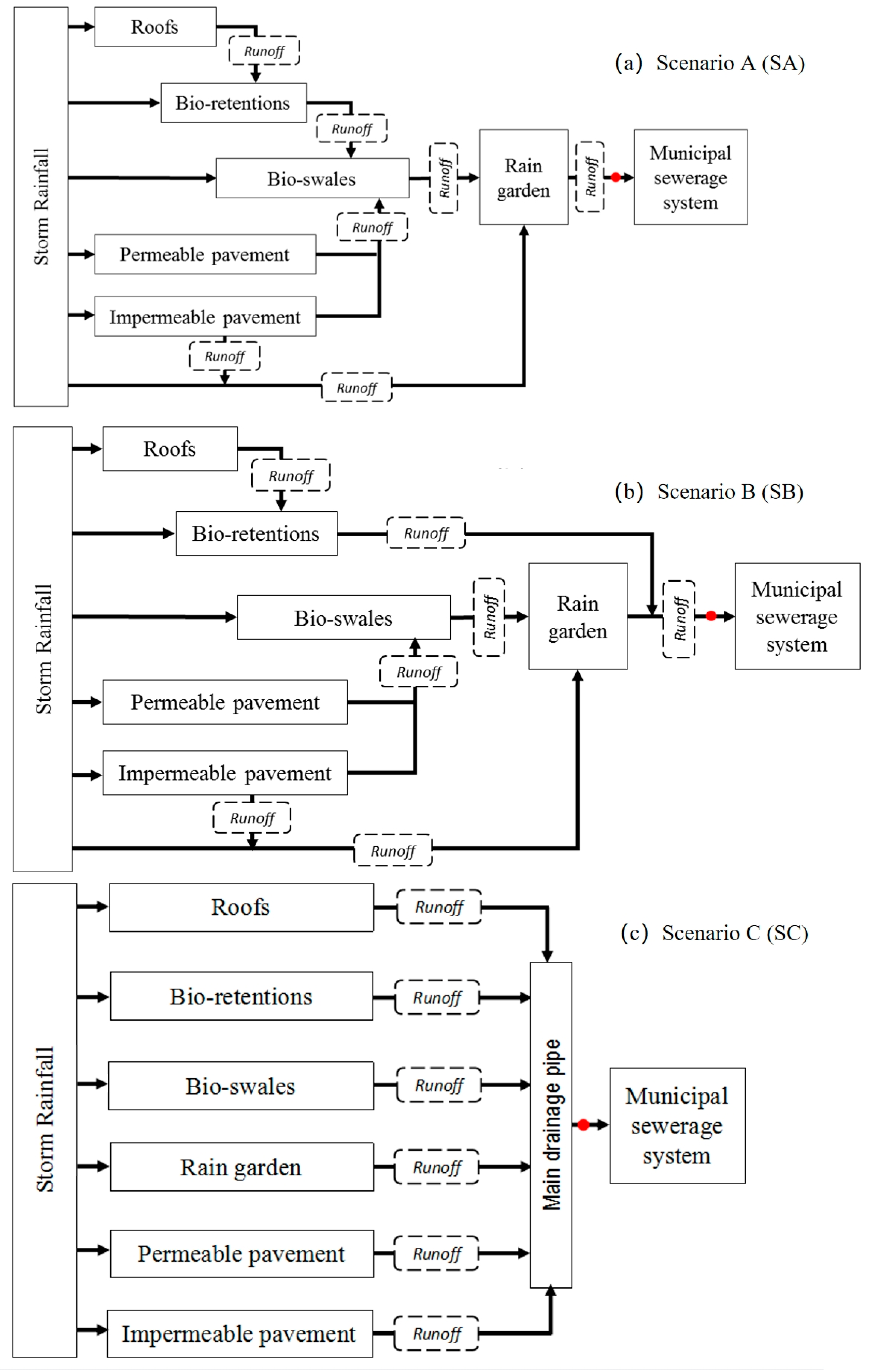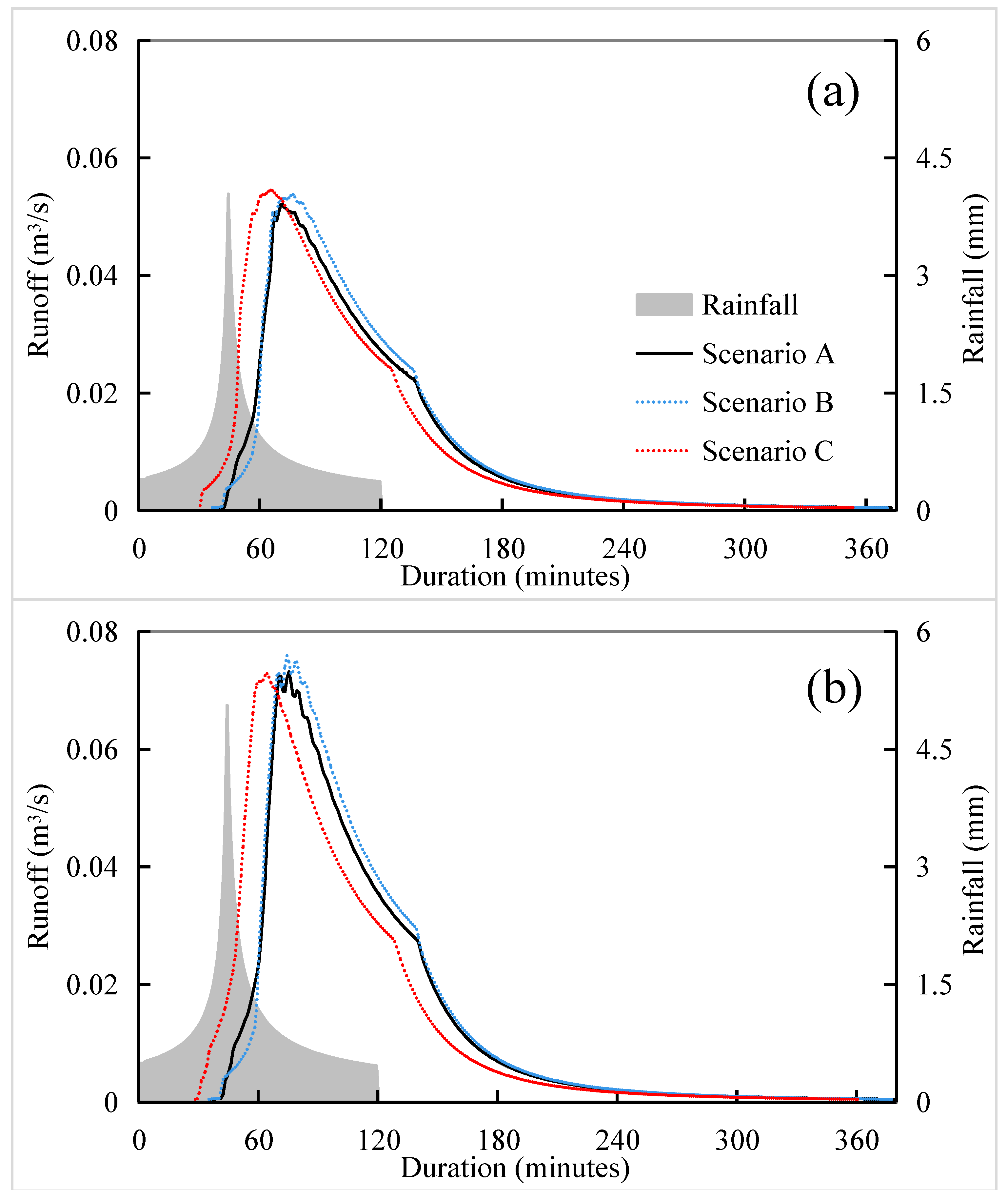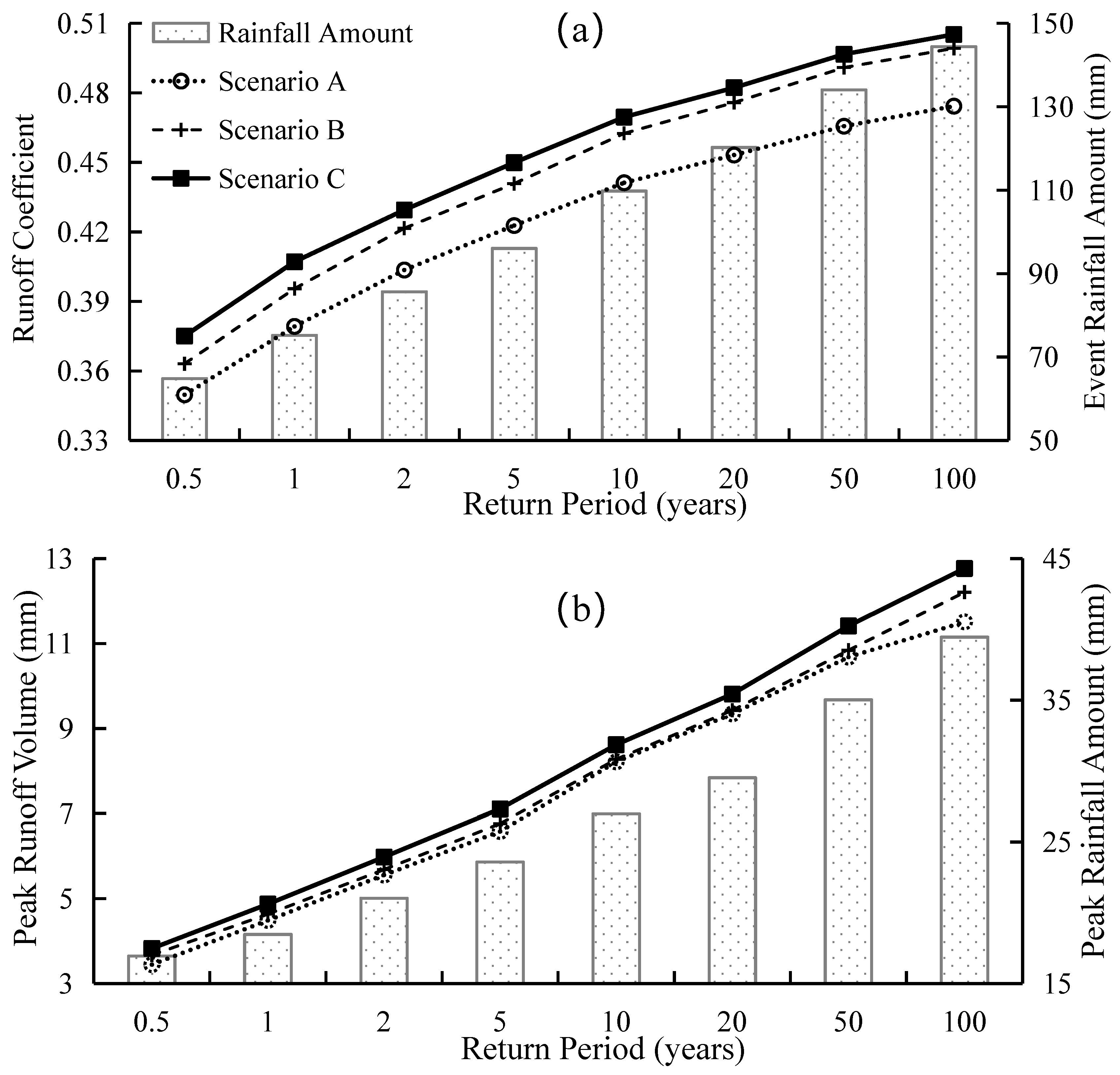The Application of Low Impact Development Facility Chain on Storm Rainfall Control: A Case Study in Shenzhen, China
Abstract
:1. Introduction
2. Materials and Methods
2.1. Study Area Description
2.2. Data Monitoring
2.3. LID Connection Scenarios Design
2.4. Hydrological Model
- (1)
- SWMM
- (2)
- Model Calibration
2.5. Storm Rainfall Design
3. Results
3.1. The Calibration and Validation Results of SWMM
3.2. The Impact of the Return Periods of Storms on Runoff in LID Chains
3.3. The Impact of Rainfall Durations on Runoff in LID Chains
3.4. The Impact of Time-to-Peak Ratios on Runoff in LID Chains
4. Discussion
5. Conclusions
Author Contributions
Funding
Informed Consent Statement
Data Availability Statement
Acknowledgments
Conflicts of Interest
References
- Meyer, D.; Molle, P.; Esser, D.; Stéphane, T.; Masi, F.; Dittmer, U. Constructed Wetlands for Combined Sewer Overflow Treatment—Comparison of German, French and Italian Approaches. Water 2013, 5, 1–12. [Google Scholar] [CrossRef]
- Baek, S.S.; Choi, D.H.; Jung, J.W.; Lee, H.J.; Lee, H.; Yoon, K.S.; Cho, K.H. Optimizing low impact development (LID) for stormwater runoff treatment in urban area, Korea: Experimental and modeling approach. Water Res. 2015, 86, 122–131. [Google Scholar] [CrossRef]
- Mijin, S.; Fouad, J.; Raghavan, S.; Jaehak, J. Evaluating the Impact of Low Impact Development (LID) Practices on Water Quantity and Quality under Different Development Designs Using SWAT. Water 2017, 9, 193. [Google Scholar]
- Low Impact Development Technologies. Available online: https://www.wbdg.org/resources/low-impact-development-technologies (accessed on 11 March 2016).
- Zimmer, C.A.; Heathcote, I.W.; Whiteley, H.R.; Schroter, H. Low-Impact-Development Practices for Stormwater: Implications for Urban Hydrology. Can. Water Resour. J. 2007, 32, 193–212. [Google Scholar] [CrossRef]
- Li, H.; Ding, L.; Ren, M.; Li, C.; Wang, H. Sponge City Construction in China: A Survey of the Challenges and Opportunities. Water 2017, 9, 594. [Google Scholar] [CrossRef] [Green Version]
- Mills, F.; Lawrence, T.; Rakheja, A.; Darwich, A.K. Green building practices around the world. Ashrae J. 2012, 54, 48–55. [Google Scholar]
- Chris, Z.; Dafang, F.; Assela, P. Transitioning to Sponge Cities: Challenges and Opportunities to Address Urban Water Problems in China. Water 2018, 10, 1230. [Google Scholar]
- Lucas, W.C.; Sample, D.J. Reducing combined sewer overflows by using outlet controls for Green Stormwater Infrastructure: Case study in Richmond, Virginia. J. Hydrol. 2015, 520, 473–488. [Google Scholar] [CrossRef]
- Graham, P.; Maclean, L.; Medina, D.; Patwardhan, A.; Vasarhelyi, G. The role of water balance modelling in the transition to low impact development. Water Qual. Res. J. Can. 2004, 39, 331–342. [Google Scholar] [CrossRef] [Green Version]
- Qin, H.P.; Li, Z.X.; Fu, G. The effects of low impact development on urban flooding under different rainfall characteristics. J. Environ. Manag. 2013, 129, 577–585. [Google Scholar] [CrossRef] [Green Version]
- Montalto, F.; Behr, C.; Alfredo, K.; Wolf, M.; Arye, M.; Walsh, M. Rapid assessment of the cost-effectiveness of low impact development for CSO control. Landsc. Urban Plan. 2007, 82, 117–131. [Google Scholar] [CrossRef]
- Li, J.; Banting, D.; Joksimovic, D.; Walters, M. Evaluation of Low Impact Development Stormwater Technologies and Water Reuse Options for the Lake Simcoe Regions. In Proceedings of the Low Impact Development 2010: Redefining Water in the City, San Francisco, CA, USA, 11–14 April 2010; pp. 1585–1596. [Google Scholar]
- Palhegyi, G.E. Designing Storm-Water Controls to Promote Sustainable Ecosystems: Science and Application. J. Hydrol. Eng. 2010, 15, 504–511. [Google Scholar] [CrossRef]
- Jeon, J.H.; Lim, K.J.; Choi, D.; Kim, T.D. Modeling the Effects of Low Impact Development on Runoff and Pollutant Loads from an Apartment Complex. Environ. Eng. Res. 2010, 15, 167–172. [Google Scholar] [CrossRef]
- Yao, L.; Wu, Z.; Wang, Y.; Sun, S.; Xu, Y. Does the spatial location of green roofs affects runoff mitigation in small urbanized catchments? J. Environ. Manag. 2020, 268, 110707. [Google Scholar] [CrossRef]
- Madrazo-Uribeetxebarria, E.; Garmendia, M.; Berrondo, J.A.; Andrés-Doménech, I. Sensitivity analysis of permeable pavement hydrological modelling in the Storm Water Management Model. J. Hydrol. 2021, 600, 126525. [Google Scholar] [CrossRef]
- Haghighatafshar, S.; Jes, L.C.J.; Aspegren, H.; Jönsson, K. Conceptualization and Schematization of Mesoscale Sustainable Drainage Systems: A Full-Scale Study. Water 2018, 10, 1048. [Google Scholar] [CrossRef] [Green Version]
- Tirpak, R.A.; Winston, R.J.; Simpson, I.M.; Dorsey, J.D.; Carpenter, D.D. Hydrologic impacts of retrofitted low impact development in a commercial parking lot. J. Hydrol. 2021, 592, 125773. [Google Scholar] [CrossRef]
- Chandana, D.; Marcio, H.; Giacomoni, C.; Prakash, K.; Hillary, H.; Andrea, R.; William, S.; Emily, M.Z. Simulation of Combined Best Management Practices and Low Impact Development for Sustainable Stormwater Management. J. Am. Water Resour. Assoc. 2010, 46, 907–918. [Google Scholar]
- Lee, J.M.; Hyun, K.H.; Choi, J.S.; Yoon, Y.J.; Geronimo, F.K.F. Flood reduction analysis on watershed of LID design demonstration district using SWMM5. Desalination Water Treat. 2012, 38, 255–261. [Google Scholar] [CrossRef]
- Jemberie, M.A.; Melesse, A.M. Urban Flood Management through Urban Land Use Optimization Using LID Techniques, City of Addis Ababa, Ethiopia. Water 2021, 13, 1721. [Google Scholar] [CrossRef]
- Samouei, S.; Zger, M. Evaluating the performance of low impact development practices in urban runoff mitigation through distributed and combined implementation. J. Hydroinformatics 2020, 22, 1506–1520. [Google Scholar] [CrossRef]
- Liang, C.; Zhang, X.; Xia, J.; Xu, J.; She, D. The Effect of Sponge City Construction for Reducing Directly Connected Impervious Areas on Hydrological Responses at the Urban Catchment Scale. Water 2020, 12, 1163. [Google Scholar] [CrossRef] [Green Version]
- Hamel, P.; Daly, E.; Fletcher, T.D. Source-control stormwater management for mitigating the impacts of urbanisation on baseflow: A review. J. Hydrol. 2013, 485, 201–211. [Google Scholar] [CrossRef]
- Sage, J.; Berthier, E.; Gromaire, M.C. Stormwater management criteria for on-site pollution control: A comparative assessment of international practices. Environ. Manag. 2015, 56, 66. [Google Scholar] [CrossRef] [PubMed] [Green Version]
- Dietz, M.E.; Clausen, J.C. Stormwater runoff and export changes with development in a traditional and low impact subdivision. J. Environ. Manag. 2008, 87, 560–566. [Google Scholar] [CrossRef] [PubMed]
- Hasan, H.H.; Razali, S.; Zaki, A.; Hamzah, F.M. Integrated hydrological-hydraulic model for flood simulation in tropical urban catchment. Sustainability 2019, 11, 6700. [Google Scholar] [CrossRef] [Green Version]
- Rossman, L.A.; Huber, W.C. Storm Water Management Model Reference Manual Volume I-Hydrology; U.S. EPA Office of Research and Development: Washington, DC, USA, 2016.
- Gorgoglione, A.; Bombardelli, F.A.; Pitton, B.; Oki, L.R.; Haver, D.L.; Young, T.M. Uncertainty in the parameterization of sediment build-up and wash-off processes in the simulation of sediment transport in urban areas. Environ. Model. Softw. 2019, 111, 170–181. [Google Scholar] [CrossRef]
- Guan, M.; Sillanpää, N.; Koivusalo, H. Modelling and assessment of hydrological changes in a developing urban catchment. Hydrol. Process. 2015, 29, 2880–2894. [Google Scholar] [CrossRef]
- Versini, P.A.; Ramier, D.; Berthier, E.; Gouvello, B.D. Assessment of the hydrological impacts of green roof: From building scale to basin scale. J. Hydrol. 2015, 524, 562–575. [Google Scholar] [CrossRef] [Green Version]
- Cipolla, S.S.; Maglionico, M.; Stojkov, I. A long-term hydrological modelling of an extensive green roof by means of SWMM. Ecol. Eng. 2016, 95, 876–887. [Google Scholar] [CrossRef]
- Yazdi, M.N.; Ketabchy, M.; Sample, D.J.; Scott, D.; Liao, H. An evaluation of HSPF and SWMM for simulating streamflow regimes in an urban watershed. Environ. Model. Softw. 2019, 118, 211–225. [Google Scholar] [CrossRef]
- Baek, S.S.; Ligaray, M.; Pyo, J.; Park, J.P.; Cho, K.H. A novel water quality module of the SWMM model for assessing low impact development (LID) in urban watersheds. J. Hydrol. 2020, 586, 124886. [Google Scholar] [CrossRef]
- Gorgoglione, A.; Castro, A.; Iacobellis, V.; Gioia, A. A Comparison of Linear and Non-Linear Machine Learning Techniques (PCA and SOM) for Characterizing Urban Nutrient Runoff. Sustainability 2021, 13, 2054. [Google Scholar] [CrossRef]
- Chen, H.; Luo, Y.; Potter, C.; Moran, P.J.; Grieneisen, M.L.; Zhang, M. Modeling pesticide diuron loading from the San Joaquin watershed into the SacramentoSan Joaquin Delta using SWAT. Water Res. 2017, 121, 374–385. [Google Scholar] [CrossRef]
- Moriasi, D.N. Model evaluation guidelines for systematic quantification of accuracy in watershed simulations. Trans. Asabe 2007, 50, 885–900. [Google Scholar] [CrossRef]
- Rodríguez, R.; Pastorini, M.; Etcheverry, L.; Chreties, C.; Gorgoglione, A. Water-Quality Data Imputation with a High Percentage of Missing Values: A Machine Learning Approach. Sustainability 2021, 13, 6318. [Google Scholar] [CrossRef]
- Barco, J.; Wong, K.M.; Stenstrom, M.K. Automatic Calibration of the U.S. EPA SWMM Model for a Large Urban Catchment. J. Hydraul. Eng. 2008, 134, 466–474. [Google Scholar] [CrossRef]
- Tsihrintzis, V.A.; Hamid, R. Runoff quality prediction from small urban catchments using SWMM. Hydrol. Process. 1998, 12, 311–329. [Google Scholar] [CrossRef]
- Jia, L.; Sample, D.J.; Bell, C.; Guan, Y. Review and Research Needs of Bioretention Used for the Treatment of Urban Stormwater. Water 2014, 6, 1069–1099. [Google Scholar]
- Ustohal, P.; Stauffer, F.; Dracos, T. Measurement and modeling of hydraulic characteristics of unsaturated porous media with mixed wettability. J. Contam. Hydrol. 1998, 33, 5–37. [Google Scholar] [CrossRef]
- Zhu, Z.; Chen, X. Evaluating the Effects of Low Impact Development Practices on Urban Flooding under Different Rainfall Intensities. Water 2017, 9, 548. [Google Scholar] [CrossRef]







| LID Unit | Number | Total Area (m2) | Thickness of Soil Layer (mm) | Thickness of Storage Layer (mm) | Plant |
|---|---|---|---|---|---|
| Bio-retention | 13 | 15.6 | 400 | 400 | Hibiscus rosa-sinensis |
| Ixora chinensis | |||||
| Bio-swale | 2 | 384 | 300 | 400 | Zoysia japonica |
| Rain garden | 1 | 20 | 500 | 400 | Miscanthus |
| Hibiscus rosa-sinensis | |||||
| Wedelia chinensis | |||||
| Pervious pavement | 1 | 487 | 125 * | 100 | / |
| Storm Event | Date | Event Precipitation (mm) | Runoff Coefficient | Peak Rainfall (mm/min) | Peak Discharge (m3/s) | Storm Duration (min) | Runoff Duration (min) |
|---|---|---|---|---|---|---|---|
| 1 | 2 July | 46.6 | 0.21 | 1.7 | 0.01 | 153 | 272 |
| 2 | 5 July | 69.7 | 0.32 | 1.9 | 0.017 | 119 | 204 |
| 3 | 16 July | 39.7 | 0.15 | 1.5 | 0.013 | 167 | 263 |
| 4 | 23 July | 33.9 | 0.11 | 1.4 | 0.006 | 195 | 286 |
| 5 | 2 August | 75.5 | 0.13 | 2.3 | 0.021 | 206 | 381 |
| 6 | 6 August | 65.3 | 0.22 | 1.8 | 0.019 | 188 | 405 |
| 7 | 10 August | 82.6 | 0.26 | 1.6 | 0.023 | 254 | 433 |
| 8 | 25 August | 31.3 | 0.16 | 1.5 | 0.012 | 197 | 311 |
| Average | -- | 55.6 | 0.19 | 1.7 | 0.015 | 185 | 319 |
| RSS (10−5) | RE (%) | RMSE (10−2) | NSE | Tpe | |
|---|---|---|---|---|---|
| Calibration | 3.3–4.8 | –8.9–9.3 | 0.18–0.47 | 0.88–0.92 | –6–4 |
| Validation | 4.2–6.1 | –10.2–12.1 | 0.67–0.82 | 0.59–0.83 | –7–6 |
| LID Unit | Soil Layer | Storage Layer | |||
|---|---|---|---|---|---|
| Porosity | Infiltration Rate (mm/h) | Field Capacity (%) | Porosity | Infiltration Rate (mm/h) | |
| Bio-retention | 0.53 | 142–155 | 11 | 0.39–0.43 | 252–267 |
| Bio-swale | 0.53 | 148 | 10 | 0.37 | 255 |
| Rain garden | 0.52 | 155 | 12 | 0.35 | 261 |
| Pervious pavement | 0.58 | 230 | 6 | 0.36 | 289 |
| Parameter | N-Imperv | N-Perv | D-Imperv | D-Perv | Width | %Z-Imperv | CR |
|---|---|---|---|---|---|---|---|
| Value | 0.012 | 0.1 | 1.5 mm | 5 mm | 45.7 m | 23 | 0.013 |
Publisher’s Note: MDPI stays neutral with regard to jurisdictional claims in published maps and institutional affiliations. |
© 2021 by the authors. Licensee MDPI, Basel, Switzerland. This article is an open access article distributed under the terms and conditions of the Creative Commons Attribution (CC BY) license (https://creativecommons.org/licenses/by/4.0/).
Share and Cite
Zhang, Y.; Xu, H.; Liu, H.; Zhou, B. The Application of Low Impact Development Facility Chain on Storm Rainfall Control: A Case Study in Shenzhen, China. Water 2021, 13, 3375. https://doi.org/10.3390/w13233375
Zhang Y, Xu H, Liu H, Zhou B. The Application of Low Impact Development Facility Chain on Storm Rainfall Control: A Case Study in Shenzhen, China. Water. 2021; 13(23):3375. https://doi.org/10.3390/w13233375
Chicago/Turabian StyleZhang, Ying, Hongliang Xu, Honglei Liu, and Bin Zhou. 2021. "The Application of Low Impact Development Facility Chain on Storm Rainfall Control: A Case Study in Shenzhen, China" Water 13, no. 23: 3375. https://doi.org/10.3390/w13233375
APA StyleZhang, Y., Xu, H., Liu, H., & Zhou, B. (2021). The Application of Low Impact Development Facility Chain on Storm Rainfall Control: A Case Study in Shenzhen, China. Water, 13(23), 3375. https://doi.org/10.3390/w13233375






